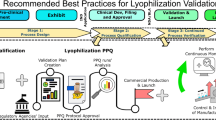Abstract
To incorporate quality by design concepts into the management of leachables, an emphasis is often put on understanding the extractable profile for the materials of construction for manufacturing disposables, container-closure, or delivery systems. Component manufacturing processes may also impact the extractable profile. An approach was developed to (1) identify critical components that may be sources of leachables, (2) enable an understanding of manufacturing process factors that affect extractable profiles, (3) determine if quantitative models can be developed that predict the effect of those key factors, and (4) evaluate the practical impact of the key factors on the product. A risk evaluation for an inhalation product identified injection molding as a key process. Designed experiments were performed to evaluate the impact of molding process parameters on the extractable profile from an ABS inhaler component. Statistical analysis of the resulting GC chromatographic profiles identified processing factors that were correlated with peak levels in the extractable profiles. The combination of statistically significant molding process parameters was different for different types of extractable compounds. ANOVA models were used to obtain optimal process settings and predict extractable levels for a selected number of compounds. The proposed paradigm may be applied to evaluate the impact of material composition and processing parameters on extractable profiles and utilized to manage product leachables early in the development process and throughout the product lifecycle.








Similar content being viewed by others
References
International Conference on Harmonization (ICH). ICH Q8 Pharmaceutical Development. 2009 [cited 2014 Apr 9]. Available from: http://www.ich.org/products/guidelines/quality/article/quality-guidelines.html.
International Conference on Harmonization (ICH). ICH Q9 Quality Risk Management. 2005 [cited 2014 Apr 9]. Available from: http://www.ich.org/products/guidelines/quality/article/quality-guidelines.html.
Norwood DL, Ball D, Blanchard J, Celado L, Deng TJ, DeGrazio F, et al. Safety thresholds and best practices for extractables and leachables in orally inhaled and nasal drug products. Product Quality Research Institute. 2006 [cited 2014 Apr 9]. Available from: http://www.pqri.org/pdfs/LE_Recommendations_to_FDA_09-29-06.pdf.
Ding W, Martin J. Implementation of single-use technology in biopharmaceutical manufacturing: an approach to extractables and leachables studies, part three—single use systems. BioProcess International. 2010;52–9.
Jenke D. Compatibility of pharmaceutical products and contact materials. Safety considerations associated with extractables and leachables. Hoboken: Wiley; 2009.
Lam M, Knotts N, Jones G, Duffield W, Shaw AJ, Roan S, Stults CLM. Use of designed experiments to understand and control variability of extractables. Poster presented at IPAC-RS Conference: Doing the Right Thing in the Changing Culture of Design and Development of Inhalation and Nasal Drug Products: Science, Quality, and Patient-Focus; 2008 Sept 22–24; Bethesda, Maryland.
Stults CLM, Ansell JM, Shaw AJ, Nagao LM. Evaluation of extractables in processed and unprocessed polymer materials used for pharmaceutical applications. AAPS Pharm Sci Tech (in press).
Myers RH, Montgomery DC, Anderson-Cook CM. Response surface methodology: product and process optimization using designed experiments. 3rd ed. New York: Wiley; 2009.
Jenke D. Application of quality by design (QbD) principles to extractables/leachables assessment. Establishing a design space for terminally sterilized aqueous drug products stored in a plastic packaging system. PDA J Pharm Sci Technol. 2010;527–35.
Ball DJ, Norwood DL, Stults CLM, Nagao LM, editors. Leachables and extractables handbook: safety evaluation, qualification, and best practices applied to inhalation drug products. Hoboken: Wiley; 2012.
Acknowledgments
The authors wish to thank the members of the IPAC-RS L&E Development Paradigm Working Group for their valuable contributions to this work. The ABS component molding was kindly performed by Plastiape.
Author information
Authors and Affiliations
Corresponding author
Additional information
Statistical analysis of extractable data from parts processed via a design of experiments is used to investigate risk-based approaches to leachable management.
Rights and permissions
About this article
Cite this article
Stults, C.L.M., Mikl, J., Whelehan, O. et al. A Risk-Based Approach to Management of Leachables Utilizing Statistical Analysis of Extractables. AAPS PharmSciTech 16, 315–326 (2015). https://doi.org/10.1208/s12249-014-0221-9
Received:
Accepted:
Published:
Issue Date:
DOI: https://doi.org/10.1208/s12249-014-0221-9




